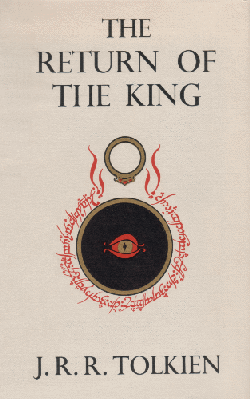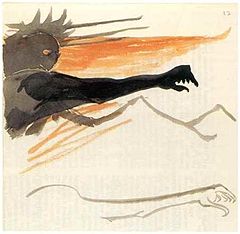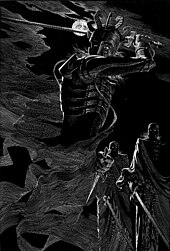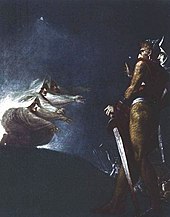
Gandalf is a protagonist in J. R. R. Tolkien's novels The Hobbit and The Lord of the Rings. He is a wizard, one of the Istari order, and the leader of the Fellowship of the Ring. Tolkien took the name "Gandalf" from the Old Norse "Catalogue of Dwarves" (Dvergatal) in the Völuspá.
The Nazgûl, introduced as Black Riders and also called Ringwraiths, Dark Riders, the Nine Riders, or simply the Nine, are fictional characters in J. R. R. Tolkien's Middle-earth. They were nine Men who had succumbed to Sauron's power through wearing Rings of Power, which gave them immortality but reduced them to invisible wraiths, servants bound to the power of the One Ring and completely under Sauron's control.
Éowyn is a fictional character in J. R. R. Tolkien's The Lord of the Rings. She is a noblewoman of Rohan who calls herself a shieldmaiden.
In J. R. R. Tolkien's Middle-earth fiction, Man and Men denote humans, whether male or female, in contrast to Elves, Dwarves, Orcs, and other humanoid races. Men are described as the second or younger people, created after the Elves, and differing from them in being mortal. Along with Ents and Dwarves, these are the "free peoples" of Middle-earth, differing from the enslaved peoples such as Orcs.

The Return of the King is the third and final volume of J. R. R. Tolkien's The Lord of the Rings, following The Fellowship of the Ring and The Two Towers. It was published in 1955. The story begins in the kingdom of Gondor, which is soon to be attacked by the Dark Lord Sauron.
Glorfindel is a fictional character in J. R. R. Tolkien's Middle-earth legendarium. He is a member of the Noldor, one of the three groups of the Calaquendi or High Elves. The character and his name, which means "blond" or "golden-haired", were among the first created for what would become part of his Middle-earth legendarium in 1916–17, beginning with the initial draft of The Fall of Gondolin. His name indicates his hair as a mark of his distinction, as the Noldor were generally dark-haired. A character of the same name appears in the first book of The Lord of the Rings, The Fellowship of the Ring, which takes place in Middle-earth's Third Age. Within the story, he is depicted as a powerful Elf-lord who could withstand the Nazgûl, wraith-like servants of Sauron, and holds his own against some of them single-handedly. Glorfindel and a version of the story of the Fall of Gondolin appear in The Silmarillion, posthumously published in 1977.
The Battle of the Pelennor Fields, in J. R. R. Tolkien's novel The Lord of the Rings, was the defence of the city of Minas Tirith by the forces of Gondor and the cavalry of its ally Rohan, against the forces of the Dark Lord Sauron from Mordor and its allies the Haradrim and the Easterlings. It was the largest battle in the War of the Ring. It took place at the end of the Third Age in the Pelennor Fields, the townlands and fields between Minas Tirith and the River Anduin.

The Return of the King is a 1980 American-Japanese animated musical fantasy television film created by Rankin/Bass and Topcraft. It is an adaptation of part of J. R. R. Tolkien 1955 high fantasy novel The Lord of the Rings. It takes its name from The Return of the King, the third and final volume of the novel, and is a sequel to the 1977 film The Hobbit.
In J. R. R. Tolkien's epic fantasy novel The Lord of the Rings, the Battle of the Morannon or the Battle of the Black Gate, is the final confrontation in the War of the Ring. Gondor and its allies send a small army ostensibly to challenge Sauron at the entrance to his land of Mordor; he supposes that they have with them the One Ring and mean to use it to defeat him. In fact, the Ring is being carried by the hobbits Frodo Baggins and Sam Gamgee into Mordor to destroy it in Mount Doom, and the army is moving to distract Sauron from them. Before the battle, a nameless leader, the "Mouth of Sauron", taunts the leaders of the army with the personal effects of Frodo and Sam. Battle is joined, but just as it seems the army of Gondor will be overwhelmed, the Ring is destroyed, and the forces of Sauron lose heart. Mount Doom erupts, and Sauron's tower, Barad-dûr, collapses, along with the Black Gate. The army of Gondor returns home victorious, the War of the Ring won.
The fictional races and peoples that appear in J. R. R. Tolkien's fantasy world of Middle-earth include the seven listed in Appendix F of The Lord of the Rings: Elves, Men, Dwarves, Hobbits, Ents, Orcs and Trolls, as well as spirits such as the Valar and Maiar. Other beings of Middle-earth are of unclear nature such as Tom Bombadil and his wife Goldberry.

Saruman, also called Saruman the White, later Saruman of Many Colours, is a fictional character of J. R. R. Tolkien's fantasy novel The Lord of the Rings. He is leader of the Istari, wizards sent to Middle-earth in human form by the godlike Valar to challenge Sauron, the main antagonist of the novel, but eventually he desires Sauron's power for himself and tries to take over Middle-earth by force from his base at Isengard. His schemes feature prominently in the second volume, The Two Towers; he appears briefly at the end of the third volume, The Return of the King. His earlier history is summarised in the posthumously published The Silmarillion and Unfinished Tales.
Faramir is a fictional character in J. R. R. Tolkien's The Lord of the Rings. He is introduced as the younger brother of Boromir of the Fellowship of the Ring and second son of Denethor, the Steward of Gondor. Faramir enters the narrative in The Two Towers, where, upon meeting Frodo Baggins, he is presented with a temptation to take possession of the One Ring. In The Return of the King, he leads the forces of Gondor in the War of the Ring, coming near to death, succeeds his father as Steward, and wins the love of Éowyn, lady of the royal house of Rohan.
Meriadoc Brandybuck, usually called Merry, is a Hobbit, a fictional character from J. R. R. Tolkien's Middle-earth legendarium, featured throughout his most famous work, The Lord of the Rings. Merry is described as one of the closest friends of Frodo Baggins, the main protagonist. Merry and his friend and cousin, Pippin, are members of the Fellowship of the Ring. They become separated from the rest of the group and spend much of The Two Towers making their own decisions. By the time of The Return of the King, Merry has enlisted in the army of Rohan as an esquire to King Théoden, in whose service he fights during the War of the Ring. After the war, he returns home, where he and Pippin lead the Scouring of the Shire, ridding it of Saruman's influence.
In J. R. R. Tolkien's Middle-earth writings, the Dúnedain were a race of Men, also known as the Númenóreans or Men of Westernesse. Those who survived the sinking of their island kingdom and came to Middle-earth, led by Elendil and his sons, Isildur and Anárion, settled in Arnor and Gondor.
Peregrin Took, commonly known simply as Pippin, is a fictional character from J. R. R. Tolkien's fantasy novel The Lord of the Rings. He is closely tied with his friend and cousin, Merry Brandybuck, and the two are together during most of the story. Pippin and Merry are introduced as a pair of young hobbits of the Shire who become ensnared in their friend Frodo Baggins's quest to destroy the One Ring. Pippin joins the Fellowship of the Ring. He and Merry become separated from the rest of the group at the breaking of the Fellowship and spend much of The Two Towers with their own story line. Impetuous and curious, Pippin enlists as a soldier in the army of Gondor and fights in the Battle of the Morannon. With the other hobbits, he returns home, helps to lead the Scouring of the Shire, and becomes Thain or hereditary leader of the land.
Théoden is a fictional character in J. R. R. Tolkien's fantasy novel, The Lord of the Rings. The King of Rohan and Lord of the Mark or of the Riddermark, names used by the Rohirrim for their land, he appears as a supporting character in The Two Towers and The Return of the King. When first introduced, Théoden is weak with age and sorrow and the machinations of his top advisor, Gríma Wormtongue, and he does nothing as his kingdom is crumbling. Once roused by the wizard Gandalf, however, he becomes an instrumental ally in the war against Saruman and Sauron, leading the Rohirrim into the Battle of the Pelennor Fields.
Aragorn is a fictional character and a protagonist in J. R. R. Tolkien's The Lord of the Rings. Aragorn was a Ranger of the North, first introduced with the name Strider and later revealed to be the heir of Isildur, an ancient King of Arnor and Gondor. Aragorn was a confidant of the wizard Gandalf, and played a part in the quest to destroy the One Ring and defeat the Dark Lord Sauron. As a young man, Aragorn fell in love with the immortal elf Arwen, as told in "The Tale of Aragorn and Arwen". Arwen's father, Elrond Half-elven, forbade them to marry unless Aragorn became King of both Arnor and Gondor.

Sauron is the title character and the primary antagonist, through the forging of the One Ring, of J. R. R. Tolkien's The Lord of the Rings, where he rules the land of Mordor and has the ambition of ruling the whole of Middle-earth. In the same work, he is identified as the "Necromancer" of Tolkien's earlier novel The Hobbit. The Silmarillion describes him as the chief lieutenant of the first Dark Lord, Morgoth. Tolkien noted that the Ainur, the "angelic" powers of his constructed myth, "were capable of many degrees of error and failing", but by far the worst was "the absolute Satanic rebellion and evil of Morgoth and his satellite Sauron". Sauron appears most often as "the Eye", as if disembodied.
J. R. R. Tolkien derived the characters, stories, places, and languages of Middle-earth from many sources. Shakespeare's influence on Tolkien was substantial, despite Tolkien's professed dislike of the playwright. Tolkien disapproved in particular of Shakespeare's devaluation of elves, and was deeply disappointed by the prosaic explanation of how Birnam Wood came to Dunsinane Hill in Macbeth. Tolkien was influenced especially by Macbeth and A Midsummer Night's Dream, and he used King Lear for "issues of kingship, madness, and succession". He arguably drew on several other plays, including The Merchant of Venice, Henry IV, Part 1, and Love's Labour's Lost, as well as Shakespeare's poetry, for numerous effects in his Middle-earth writings. The Tolkien scholar Tom Shippey suggests that Tolkien may even have felt a kind of fellow-feeling with Shakespeare, as both men were rooted in the county of Warwickshire.








